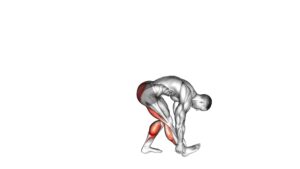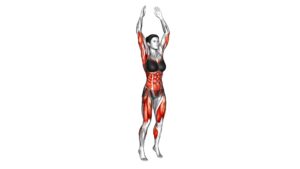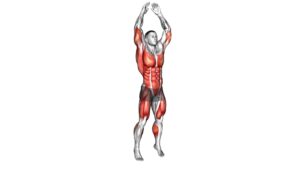Runners Stretch (female) – Video Exercise Guide & Tips

Are you looking to improve your running performance and prevent injuries? Look no further than the Runners Stretch!
Watch This Exercise Video
In this video exercise guide, you'll find tips and techniques specifically tailored for female runners. Learn how to properly execute the stretch, discover variations and modifications, and incorporate it into your pre-run warm-up and post-run recovery routines.
Get ready to take your running game to the next level with this essential stretching exercise. Let's get started!
Key Takeaways
- The Runners Stretch targets muscles used during running and improves flexibility and prevents injuries.
- Maintaining proper alignment and posture, activating targeted muscles, and avoiding common mistakes are crucial for proper form and technique.
- Standing tall with feet hip-width apart, keeping shoulders relaxed and down, and engaging abdominal muscles are important for proper alignment and posture during the Runners Stretch.
- Engaging the core, squeezing glutes, keeping shoulders down and relaxed, and maintaining a neutral spine are important muscle activation cues to focus on during the stretch.
Benefits of the Runners Stretch
To improve your running performance and prevent injuries, incorporating the runner's stretch into your routine offers numerous benefits. This stretch specifically targets the muscles used during running, helping to improve flexibility and prevent injuries. By stretching your quadriceps, hamstrings, and calves, you can increase your range of motion and reduce the risk of muscle strains and tears.
Improving flexibility is key to enhancing your running performance. When your muscles are more flexible, they're able to move through a greater range of motion, allowing for more efficient and effective movement. This can lead to improved speed, endurance, and overall performance.
Additionally, the runner's stretch helps to prevent injuries by lengthening and loosening tight muscles. Tight muscles can put added stress on your joints and increase the likelihood of sprains and strains. By regularly stretching your muscles, you can help alleviate tension and reduce the risk of injury.
Incorporating the runner's stretch into your routine not only benefits your physical performance but also promotes overall well-being. Stretching can help relieve muscle soreness, improve circulation, and enhance recovery after a run.
Proper Form and Technique
To perform the runners stretch with proper form and technique, it's important to focus on three key points.
First, maintain proper alignment and posture by keeping your spine straight and shoulders relaxed.
Second, activate the targeted muscles by engaging your core and squeezing your glutes.
Finally, avoid common mistakes such as rounding your back or overstretching, which can lead to injury.
Alignment and Posture
Maintain proper alignment and posture throughout the runners stretch by keeping your body straight and engaging your core. Proper alignment and posture are crucial for improving flexibility and maximizing the benefits of stretching.
When performing the runners stretch, stand tall with your feet hip-width apart. Keep your shoulders relaxed and down, and avoid hunching or rounding your back. Engage your abdominal muscles to support your spine and maintain a neutral position.
As you lean forward, hinge at the hips and maintain a straight line from your head to your tailbone. Avoid arching your back or collapsing your chest. By maintaining proper alignment and posture, you ensure that the stretch targets the intended muscles and minimize the risk of injury.
Muscle Activation Cues
When performing the runners stretch, focus on activating the correct muscles by using specific cues to ensure proper form and technique. Proper activation techniques are crucial for maximizing the benefits of the exercise and preventing injury.
To activate the muscles effectively, start by engaging your core by pulling your belly button towards your spine. This will stabilize your pelvis and create a strong foundation.
Next, focus on your glutes by squeezing them together as you stretch. This will help to engage the muscles in your buttocks and hips.
Additionally, make sure to keep your shoulders down and relaxed, and maintain a neutral spine throughout the stretch.
Common Mistakes to Avoid
To ensure proper form and technique during the runner's stretch, focus on avoiding these common mistakes.
- First, make sure to maintain a straight back throughout the stretch. Avoid rounding your shoulders or hunching over, as this can lead to strain or injury.
- Additionally, avoid locking your knees as you extend your leg. Instead, keep a slight bend in your knee to protect your joints.
- Another common mistake is overstretching. Remember to listen to your body and only stretch to a comfortable level, never pushing yourself too far.
- Lastly, be mindful of your breathing. Many people hold their breath during stretches, which can restrict oxygen flow and decrease the effectiveness of the stretch.
Variations and Modifications
Try different variations and modifications for the runners stretch to cater to your specific needs and abilities. There are several ways to modify the runners stretch to make it more accessible or challenging, depending on your fitness level and flexibility.
One variation to consider is the standing quad stretch. Instead of kneeling on the ground, stand upright and bring one heel towards your glutes. Grab your foot with your hand and gently pull it towards your glutes until you feel a stretch in your quadriceps. This variation allows you to stretch your quads without having to get down on the ground.
Another modification you can try is the seated runners stretch. Sit on the ground with your legs extended in front of you. Bend one leg and bring the sole of your foot to the inside of your opposite thigh. Lean forward from your hips and reach towards your extended leg, feeling a stretch in your hamstring. This seated variation is a great option for individuals who struggle with balance or have difficulty getting into the traditional runners stretch position.
Remember to listen to your body and choose variations and modifications that work best for you. By incorporating these changes, you can personalize the runners stretch to suit your needs and make it a more effective and enjoyable exercise.
Pre-Run Warm-up Routine
To properly prepare for your run, incorporate a simple and effective pre-run warm-up routine into your training regimen.
Dynamic stretching is a key component of any pre-run warm-up routine. This type of stretching involves moving parts of your body through a full range of motion, which helps to increase blood flow to your muscles and improve flexibility.
By engaging in dynamic stretching before your run, you can help prevent injuries by ensuring that your muscles are adequately warmed up and ready for the demands of running. Some examples of dynamic stretches you can incorporate into your pre-run warm-up routine include leg swings, walking lunges, and high knees.
Additionally, including exercises that target your core and glutes can help improve your running form and stability.
Post-Run Recovery and Stretching
Incorporate a 10-minute stretching routine after your run to aid in your post-run recovery and enhance muscle flexibility. Recovery techniques play a crucial role in helping your body recover from the physical stress of running and prevent injuries. Stretching is an important component of post-run recovery as it helps to alleviate muscle tightness and soreness.
Stretching after a run can also improve your overall flexibility, which is essential for maintaining proper form and preventing muscle imbalances.
When it comes to post-run stretching, it's important to focus on the major muscle groups used during running, such as the quadriceps, hamstrings, calves, and hip flexors. Holding each stretch for 15 to 30 seconds and repeating them two to three times can be beneficial in improving muscle flexibility and reducing the risk of injury. Additionally, incorporating dynamic stretches, such as leg swings and walking lunges, can help to further loosen up your muscles and improve their range of motion.
In addition to stretching, other recovery techniques that you can incorporate into your post-run routine include foam rolling, using a massage ball, or taking an ice bath. These techniques can help to reduce inflammation, increase blood flow, and promote muscle recovery.
Tips for Incorporating the Stretch Into Your Routine
To incorporate the runner's stretch into your routine effectively, it's important to consider the optimal frequency of stretching. You may wonder whether it's best to stretch before or after your run.
The key is to find what works best for you and your body, as some runners prefer to stretch before to warm up their muscles, while others find it more beneficial to stretch after to aid in recovery.
Optimal Stretch Frequency
How often should you incorporate the runners stretch into your routine? The stretching frequency and duration will depend on your individual needs and goals. However, to maximize the benefits of the runners stretch, it's generally recommended to perform it at least two to three times a week. Consistency is key when it comes to stretching, as regular practice allows your muscles to adapt and become more flexible over time.
When incorporating the runners stretch into your routine, consider the following tips:
- Prioritize quality over quantity: Focus on performing the stretch correctly rather than rushing through it.
- Listen to your body: Pay attention to any discomfort or pain during the stretch and adjust accordingly.
- Gradually increase intensity: Start with shorter durations and gradually increase the time spent in the stretch to avoid overstretching.
Stretching Before or After?
Start by including the runners stretch either before or after your running routine to optimize your flexibility and prevent injury.
Stretching before running can help warm up your muscles, increase blood flow, and prepare your body for the upcoming physical activity. It can also improve range of motion and decrease the risk of muscle strains or pulls during your run.
On the other hand, stretching after running can help cool down your muscles, reduce muscle soreness, and promote recovery. It allows your body to gradually return to its resting state and prevents the build-up of lactic acid, which can lead to muscle stiffness and fatigue.
Ultimately, the best time for stretching depends on your personal preference and the specific needs of your body. Experiment with both options to find what works best for you in preventing injuries and optimizing your running performance.
Frequently Asked Questions
Can the Runner's Stretch Help With Improving Running Speed and Performance?
The runner's stretch can definitely help improve your running speed and performance. By incorporating this stretch into your routine, you can work on enhancing your running technique and flexibility, which are crucial for optimal performance.
Additionally, the runner's stretch targets the muscles in your legs and hips, which are important for running.
However, to further boost your speed and performance, it's recommended to combine the runner's stretch with other exercises, such as strength training, to build muscle strength and endurance.
Is It Safe to Perform the Runner's Stretch if I Have a History of Knee Injuries?
If you have a history of knee injuries, it's important to consider the safety of performing the runner's stretch.
While the runner's stretch can be beneficial for improving flexibility and preventing knee injuries, it's essential to consult with a healthcare professional or physical therapist before attempting it.
They can assess your specific situation and provide alternative stretches or modifications that are more suitable for your needs.
Prioritizing knee injury prevention is crucial to ensure a safe and effective exercise routine.
How Long Should I Hold the Runner's Stretch to See Maximum Benefits?
To see maximum benefits from the runner's stretch, it's important to hold the stretch for an adequate amount of time. This will allow your muscles to fully relax and lengthen, improving flexibility.
Holding the stretch for about 30 seconds to 1 minute is a good starting point. However, if you're looking to prevent muscle imbalances, you can hold the stretch for up to 2 minutes.
Remember to listen to your body and adjust the duration based on your comfort level.
Can the Runner's Stretch Help Alleviate Lower Back Pain?
To alleviate lower back pain, the runner's stretch can be highly beneficial. By incorporating this stretch into your routine, you can improve flexibility and prevent future injuries.
This stretch specifically targets the muscles in your lower back, helping to relieve tension and tightness.
Holding the runner's stretch for an appropriate amount of time, as determined by your fitness level, will provide maximum benefits. Remember to always listen to your body and consult with a professional if you experience any discomfort.
Are There Any Specific Breathing Techniques to Follow While Performing the Runner's Stretch?
When performing the runner's stretch, it's important to focus on your breathing technique. Take deep breaths in and out, allowing your breath to guide your movements. Inhale as you prepare for the stretch, and exhale as you deepen into the stretch. This will help relax your muscles and increase flexibility.
If you have limited flexibility, you can modify the stretch by using a yoga block or a rolled-up towel to support your hands or knees.
Conclusion
Incorporating the runners stretch into your routine can provide numerous benefits, such as improved flexibility, reduced muscle soreness, and enhanced performance. By following proper form and technique, you can maximize the effectiveness of this stretch.
Additionally, variations and modifications can be implemented to target different muscle groups and cater to individual needs. Whether it's as part of a pre-run warm-up or a post-run recovery routine, the runners stretch is a valuable addition to any runner's fitness regimen.

Author
Years ago, the spark of my life’s passion ignited in my mind the moment I stepped into the local gym for the first time. The inaugural bead of perspiration, the initial endeavor, the very first surge of endorphins, and a sense of pride that washed over me post-workout marked the beginning of my deep-seated interest in strength sports, fitness, and sports nutrition. This very curiosity blossomed rapidly into a profound fascination, propelling me to earn a Master’s degree in Physical Education from the Academy of Physical Education in Krakow, followed by a Sports Manager diploma from the Jagiellonian University. My journey of growth led me to gain more specialized qualifications, such as being a certified personal trainer with a focus on sports dietetics, a lifeguard, and an instructor for wellness and corrective gymnastics. Theoretical knowledge paired seamlessly with practical experience, reinforcing my belief that the transformation of individuals under my guidance was also a reflection of my personal growth. This belief holds true even today. Each day, I strive to push the boundaries and explore new realms. These realms gently elevate me to greater heights. The unique combination of passion for my field and the continuous quest for growth fuels my drive to break new ground.







